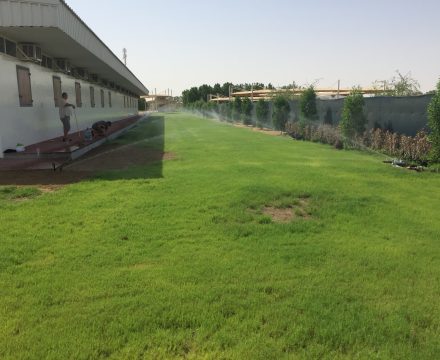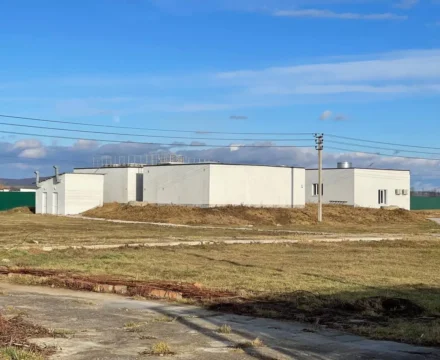Basic terms and concepts of biological treatment
Basic terms and concepts of biological treatment.
Extended aeration.
Extended aeration should be understood as the process of complete biological oxidation (complete biological treatment) in the presence of dissolved oxygen. When conducting extended aeration, one of the basic laws of engineering chemistry must be observed – the process must continue for as long as possible. Only in this case will the reaction products contain a minimum amount of impurities. In our case, the reaction products are water, carbon dioxide and nitrogen.
The duration of extended aeration is determined by the following formula:
ta = (Lin – Lout) / ρ (1 – S) a, h/time where:
Lin – Lout– The difference between the values of BOCtotal (Biological oxygen consumption) at the inlet and outlet of the aeration tank, mg O2/l;
ρ – The specific rate of complete oxidation of organic substances by one gram of activated sludge (based on ash-free matter), mg BOCtotal/1g*h);
(For a bioreactor designed for extended aeration and complete oxidation of organic matter, it is taken equal to 6.0 mg BOCtotal/1g*h or 6.0 g BOCtotal/1kg*h);
a – Concentration of microorganisms, (dose of activated sludge), g/l or kg/m3. (For aeration tanks with free-floating activated sludge, its dose is taken within 1.5 – 2.5 g/l. For bioreactors with floating polymer loading, the recommended dose of sludge is 2.5 – 3.5 g/l.
S – Ash content of biomass (usually taken equal to 0.3 – 0.35 or 30 – 35%).
Bioreactor volume
The bioreactor volume is determined by the formula:
Wa = Qh * ta, m3
So, for wastewater treatment plants with a capacity of 24 m3/day (Qh = 1 m3/hour), with the amount of pollution coming from one person in terms of BOCtotal 75 g/(day*person) (according to DBN V.2.5-75-2013 ) and the wastewater discharge rate of 0.2 m3/(day*person), with the permissible value of BOCtotal at the outlet of the wastewater treatment plants 20 mgO2/l, the required aeration time will be:
ta = (75 / 0.2 – 20) / (6 x 2.5 (1 – 0.35)) = 36.4 hours.
Then, the required volume of the aeration tank will be:
Then, the required volume of the aeration tank will be:
Wa = 1 x 36.4 = 36.4 m3
Note:
Real data on the concentration of suspended solids, ammonium nitrogen and the value of BOC (Biological oxygen consumption) in wastewater entering such treatment plants indicate a significant overestimation of the daily norms given in DBN V.2.5-75-2013. In other words, the actual amount of incoming suspended solids and BOD is 1.5 – 2.0 times lower than the established norms. This indicates that the real purification effect will be somewhat higher than the calculated one. The norms specified in DBN are rather the maximum possible. Speaking about MOS, one should also take into account the slowing effect on the rate of oxidation of pollutants of possible volley discharges of detergents (SPAR), disinfectants and other xenobiotics. At the same time, the smaller the inflow of wastewater, the more noticeable the impact of xenobiotics on the biological treatment process. Thus, the calculation of treatment facilities, in order to prevent the passage of pollutants, should be carried out based on these data.
Increase and removal of excess activated sludge.
Increase of activated sludge is an important parameter of the operation of treatment facilities and means the entire mass of waste products of bacteria and other pollutants introduced with wastewater (mineral (insoluble) part of suspended solids and difficultly oxidizable organics), no longer susceptible to biological oxidation, which as a result of reproduction.
Increase of activated sludge is determined by the following formula:
Pr = ((1- ∆)(Cin – Cout)+ ∆pr (Lin – Lout) · Qdav = g/day;
Where:
Lin – Lout – Total BOC value at the inlet and outlet, mgO2/l;
Cin – Sout – Concentration of suspended solids at the inlet and outlet, mg/l;
∆ – The fraction of organic impurities of suspended solids that are subject to hydrolysis;
∆pr – The mineralized fraction increases bacterial biomass;
The value of the sludge growth rate indicates that during the day the mass of activated sludge in the treatment plants will increase by the value found. In this case, it is this amount of sludge that must be removed from the bioreactor and is called excess activated sludge. Excess activated sludge must be removed regularly and properly, since at a higher concentration of activated sludge (with insufficient removal), secondary pollution of the wastewater being treated will occur, and at a lower concentration of sludge (with removal of sludge greater than the mass of its increase) – the system will be unable to cope with the purification of incoming pollutants.
With continued aeration and the use of spatial succession of hydrobionts attached to the polymer loading, when the hydrobionts of the next stage of purification feed on microorganisms of the previous one, it is possible to achieve very impressive results:
In terms of 1 person in treatment facilities of this type, 2 – 4 g/day or 0.1 – 0.2 l/day of gravitationally compacted excess activated sludge (at a humidity of 98%). In the presence of a sludge compactor, the humidity of the sludge can be reduced to 96%. Then, accordingly, the volume of sludge will decrease to 0.05 – 0.1 l/(day*person).
The volume of excess sludge formed at treatment plants using the classical scheme is:
40 – 70 g / (day*person) or 2 – 3.5 l / (day*person).
Increase in activated sludge in a PLATON type WWTP
The volume of excess sludge at a PLATON type WWTP with a capacity of 100 m3/day with an equivalent population of 500 people will be 25 – 50 l/day, and at treatment plants of the same capacity using the classical scheme scheme, 1000 – 1750 l/day of sludge will be formed. If there is an aerobic stabilizer in the standard scheme, which occupies a volume that ensures the sludge to stay for 7 -10 days, namely 10 – 15 m3 (10-15% of the volume of the aeration tank), the amount of sediment will decrease to 500 – 875 l/day. And no less. See table:
| Volume of excess sludge, l/day</ strong> | ||
| Platon type wastewater treatment plants</strong > | Classical wastewater treatment plants | Classical structures with aerobic stabilizer |
| 25 – 50 | 1000 – 1750 | 500 – 875 |
🔹With PLATON technology, you can do without sludge platforms altogether and, having a sludge storage volume of 3–4 m3 (2-3% of the volume of the aeration tank), remove sludge with a sewage treatment plant once every 2-3 months, 1 machine.
🔹When building classical treatment plants, it makes sense to think about building sludge platforms or installing a mechanical sludge dewatering unit.
Treatment plants using PLATON technology are also built with an increased aeration tank volume of 2.5–3 times compared to the classical scheme and are equipped with a polymer loading. This leads to savings in the area occupied by treatment facilities and reduced operating costs.
Sludge age.
Activated sludge microorganisms have their own life cycle. As a result of exchange processes with the environment and intracellular metabolism, microorganisms grow and develop – the renewal of cellular matter and, as the cell ages, its chemical composition changes, for example, the water content decreases. Thus, we can talk about “young” and “old” activated sludge. The age of the sludge is determined by the time the activated sludge stays in the aeration tank until it is removed as excess sludge. It is defined as the ratio of the mass of activated sludge in the bioreactor to the daily mass of excess activated sludge.
| Age= | and Wа | , day. |
| Pr·Qdob |
The age of the sludge determines its physiological state and significantly affects the intensity of the oxidation processes, sludge precipitation, nitrogen and phosphorus assimilation by sludge microorganisms, nitrification of ammonium nitrogen and denitrification. Maintaining the age of the sludge in a certain range allows you to ensure optimal conditions for biomass development to achieve the set technological parameters of the removal and oxidation of organic pollutants from wastewater entering the aeration facility. This task is solved by maintaining the optimal amount of biomass at each stage of the bioreactor by removing the biomass growth from it and ensuring the appropriate duration of its contact with pollutants.
“Swelling” of activated sludge.
When “sick” for some reason, the sludge becomes depressed, bacteria practically cease to oxidize pollutants and begin to sorb them, the volume of activated sludge increases sharply (the sludge “swells”), which leads to a violation of the purification process.
The following reasons can lead to this phenomenon:
- 🔹 Incoming organics to wastewater treatment in quantities exceeding the design (activated sludge does not have time to oxidize incoming pollutants);
- 🔹 Discharge of petroleum products, fats and SPAR to wastewater treatment in quantities exceeding the MPC (while activated sludge flakes are coated with a film that prevents oxygen from reaching activated sludge bacteria);
- 🔹 Discharge of wastewater containing substances toxic to activated sludge bacteria in quantities exceeding the MPC for admission to urban sewerage networks;
- 🔹 Discharge of wastewater with a temperature below +5 degrees;
- 🔹 pH exceeding 6.5-8.5, increased concentration of Cl- salts (more than 350 mg/l) and etc.
It is impossible to arrange large storage tanks without aeration in front of the MOS, because an anaerobic process will take place there with the release of hydrogen sulfide, which has an inhibitory effect on the bacteria of the activated sludge MOS.
Biological removal of nitrogen and phosphorus.
One of the main pollutants of wastewater is nitrogen and phosphorus. When treating wastewater, it is necessary to create conditions for their biological removal. To do this, it is necessary to ensure the alternation of anoxic and oxic conditions in the MOS zones, with an activated sludge age of more than 25 days.
Nitrogen removal
It is necessary to provide for 2-stage nitrification and denitrification, given the complexity of these processes and the sharply changing concentrations of ammonium nitrogen and easily oxidizable organics in wastewater, that are entering the treatment.
For example, if there is a large amount of ammonium nitrogen, it will be oxidized to nitrites, and then to nitrates. If there is not a sufficient amount of easily oxidizable organic matter, the denitrification process will not be complete, and the required nitrogen indicators will not be provided at the output. If the installation has several treatment zones with multi-circuit reverse recirculation of activated sludge, then: firstly, nitrification proceeds well, since it begins after the oxidation of the main part of the organic matter, which cannot be carried out in one aeration tank, and secondly – nitrites with nitrates are early or will encounter organic matter late, which is easily oxidized in conditions of oxygen deficiency to undergo denitrification.
Phosphorus Removal
Phosphorus removal occurs mainly through the removal of excess activated sludge, in which it is accumulated by PP-bacteria. Conventional activated sludge contains 1.5-2% phosphorus, and in sludge periodically exposed to oxygen and anoxic conditions, phosphorus accumulates in large quantities (6-8%) by PP-bacteria. Excess activated sludge must be removed automatically from the aerobic zone, since phosphorus accumulated by PP-bacteria in the aerobic zone, when exposed to anoxic conditions, is converted to a dissolved state.
Load on activated sludge.
Load on activated sludge is another important parameter of the operation of treatment plants. It is defined as the ratio of the mass of BOC removed (Lin – Lout) * Qadd to the mass of activated sludge in the system (a · W).When loading the activated sludge up to 150 mg BOC (Biological oxygen consumption) per 1 g of ashless activated sludge substance per day, the bioreactor can be classified as a lightly loaded type. Bioreactors of this type are characterized by minimal increase in activated sludge, high and stable purification effect under pulsating loads. Effluent treatment in such bioreactors is accompanied by nitro-denitrification processes. Sedimentation characteristics of the sludge are good (hydraulic size is high (1.4 – 1.8 mm/sec), sludge index is low (70 – 90 ml/g)).
The sludge index is the volume of water that contains 1 g of dry sludge.
Prolonged aeration with cyclic aeration and mixing processes in reactors.
With prolonged aeration with alternating aeration and mixing in reactors at an age of activated sludge of more than 30 days, facultative microorganisms develop, which actively participate in the purification processes, both in oxygenic and anaerobic conditions. Thanks to this, the amount of aerobic sludge in the system increases, nitrifying and denitrifying bacteria are cultivated – as a result, nitrogen and partially phosphorus are effectively removed biologically. In other words, one of the solutions for optimizing the purification process can be become a scheme with sequentially placed SBR reactors. However, this scheme, for its implementation, requires a complex and flexible control algorithm, a large number of level sensors and control elements (valves). In our realities, it is not always possible to adequately adjust the cleaning mode of OSs that operate according to such a scheme. An example of this is periodic failures in the operation of such “thought-out” and “correct” OSs as “Biotal”.
 Lake water purification. Sports hotel “Chevalier Panorama”, BukovelGo to
Lake water purification. Sports hotel “Chevalier Panorama”, BukovelGo to Filtration of water from the river. “GasthauS” Hotel, BukovelGo to
Filtration of water from the river. “GasthauS” Hotel, BukovelGo to Water desalination. United Arab Emirates, DubaiGo to
Water desalination. United Arab Emirates, DubaiGo to Hotel wastewater treatment. Hotel “Carparosa Hotel & Restaurant”, BukovelGo to
Hotel wastewater treatment. Hotel “Carparosa Hotel & Restaurant”, BukovelGo to Filter station. Enterprise “UPG-Invest” TM “Syaivir” v. MamaevtsyGo to
Filter station. Enterprise “UPG-Invest” TM “Syaivir” v. MamaevtsyGo to





